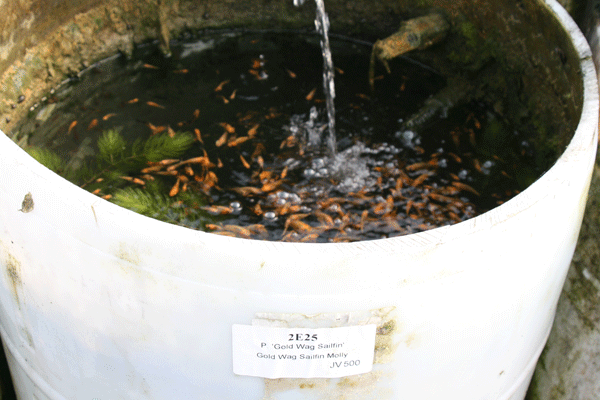Photo shows juvenile mollies in a vat ready to eat.
Fish tip, How to Feed Your Fish:
This tip was first published in our Newsletter No. 1, August 2013. I’m reposting it as a blog so that it can be searched for on our website and in my blogs. Here it is:
Get plastic fish; they require no care! Okay, seriously, feeding is one of the most misunderstood aspects of the hobby. Probably because it’s a double-edged sword. Feed too little and your fish become emaciated and sick. Feed too much and water quality suffers. That said, most overfeeding is caused by not understanding your fishes’ feeding habits. Most aquarium fish are grazers as opposed to gorgers. Let’s take care of the gorgers first.
Gorgers eat large meals infrequently. A good example of a gorger is an Oscar (Astronotus ocellatus). Oscars will happily eat a fish that can barely fit into its mouth and then not eat for a couple of days. They “gorge” and then digest slowly. In nature, they are top predators similar to North America’s Largemouth Bass (Micropterus salmoides). Some catfish such as the various Shovelnose Cat species are also gorgers. Gorgers are predators that eat large meals at one time and then rest to digest. Their stomachs are designed to distend allowing them to ingest large meals.
Grazers, on the other hand, eat pretty much continuously throughout the day (or night for nocturnal species). Their stomachs are small and not distensible. They eat small meals that are rapidly digested, emptying the stomach for more food. In nature grazers eat as they encounter food, but can only hold so much at a time. This presents problems in captivity. Grazers will eat what they can and then quit, only to get hungry again in an hour or so. Excess food from one feeding is usually inedible after an hour or two in the water and the fish reject it.
So here’s the tip: feed your fish only what they will clean up within a minute or two. Watch your fish to see what this amount is. Then, an hour or two later feed them again. Often your fish won’t eat as much this second time. Continue to do this and allow your fish to teach you how much to feed them. After a while of watching and adjusting the amount you feed, you’ll be fully trained to feed your fish what they need and will eat. I like to feed my fish every time I walk by the aquarium. The first feeding of the morning I give them a liberal amount, but one that they’ve trained me to feed them. Subsequent feedings are smaller amounts. Your fishes’ enthusiasm about food will tell you if you are overfeeding. Lack of enthusiasm means you should reduce the amount. Voracious feeding means you aren’t giving them enough. Remember, well fed fish are usually healthy fish.


Leave a Reply